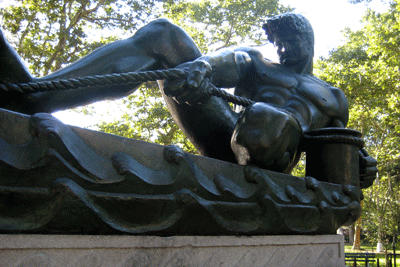
Greenpoint's got history oh! that's for sure; home of the Monitor and our own walking tour.
- Buttwhistle / Monty

Important note: for the full effect play the song above as you browse this section.
Remember: for maximum amusement generation play the song at the top of this page.
from - DEPARTMENT OF THE NAVY -- NAVAL HISTORICAL CENTER

Monitor:
A person or thing that warns or instructs. Ericsson suggested the name hoping that his novel warship would admonish the South and Great Britain which was then sympathetic to the Confederacy.
The prime contract for construction of Monitor was awarded to her designer John Ericsson on 4 October 1861. Construction of her hull was subcontracted to the Continental Iron Works at Green Point, Long Island; fabrication of her engines was delegated to Delamater & Co., New York City; and the building of her turret, composed of eight layers of 1-inch iron plates, was assigned to Novelty Iron Works, also of New York City. The unusual warship—the first ironclad in the U.S. Navy—was launched 30 January 1862; and commissioned 25 February, Lt. John L. Worden in command.

The ironclad departed New York Navy Yard 27 February 1862, but a steering failure caused her to return to port. On 6 March, she again departed the New York Navy Yard, though this time she was under tow by Seth Low, and headed for the Virginia Capes.
As Monitor approached Cape Henry on the afternoon of 8 March, CSS Virginia, the former U.S. steam frigate Merrimack—now rebuilt as an ironclad ram—steamed out of the Elizabeth River into Hampton Roads and attacked the wooden hulled Union warships blockading Norfolk. Flag Officer Franklin Buchanan, the Confederate commander, singled out sailing sloop Cumberland as his first victim.
She opened the engagement when less than a mile distant from Cumberland and the firing became general from blockaders and shore batteries; but most shots from the Union guns glanced harmlessly off the Confederate ironclad's slanted sides. Virginia rammed Cumberland below the waterline and she sank rapidly. Buchanan later reported the Union sailors remained “gallantly fighting her guns as long as they were above water.” Buchanan next turned Virginia's attention on the frigate Congress, which had run hard aground while attempting to close, and the set her ablaze with hot shot and incendiary shell. She also damaged Minnesota before retiring to Sewell's Point for the night.
Monitor's crew could hear the roar of cannon as they rounded Cape Henry into Chesapeake Bay and headed toward the scene of battle. But all was quiet when she hove to alongside Roanoke. Captain Marston directed Worden to assist battered Minnesota, hard aground off Newport News.
At dawn, Virginia again emerged and headed toward Minnesota to administer the coup de grace. Monitor steamed out of Minnesota's shadow to intercept the Confederate ironclad ram. A Confederate officer on CSS Patrick Henry, one of Virginia's paddle wheel consorts, described the Union challenger as “an immense shingle floating on the water with a gigantic cheese box rising from its center; no sails, no wheels, no smokestack, no guns.” But the unusual federal vessel soon won the respect of friend and foe alike, fighting the Confederate ironclad to a standstill in an exhausting four-hour duel. With both warships damaged and running low on shot, Virginia retired to Sewell’s point after failing to break the Federal blockade.
In the weeks that followed, Monitor remained alert in Hampton Roads ready to renew the engagement should Virginia venture forth. The southern ram did make a brief appearance off Sewell's Point on 11 April, but neither side forced a second engagement between the two vessels. Early in May, while General McClellan pushed through Yorktown and up the peninsula toward Richmond, the South withdrew from Norfolk and the southern bank of the James River, retiring toward the Confederate capital. Virginia, with too deep a draft to reach Richmond, was set afire 11 May and blew up soon thereafter.
Monitor, reinforced by ironclads Galena and Naugatuck, steamed up the James to gather information for McClellan and to strengthen the Union Army's left flank. On 15 May, however, when they reached Drury's Bluff some eight miles below the southern capital, their progress was stopped by obstructions across the channel. Confederate riflemen fired on the Union ships from both shores and heavy naval guns mounted high on the cliff shelled them from an angle which minimized the effectiveness of their armor. Although Monitor moved up to protect the heavily damaged Galena, her crew was unable to elevate her guns to hit the shore batteries, and so the ironclads retreated downstream.
Although checked in their thrust toward Richmond, the Union ships continued to provide McClellan with gunfire support. After his defeat by General Lee in the Seven days campaign, their guns helped save the Army of the Potomac from annihilation.

At midsummer, Monitor helped cover the Union Army as it retired from the peninsula to shift operations back to northern Virginia. Thereafter, she performed blockade duty in Hampton Roads until ordered on Christmas Eve to proceed to North Carolina for operations against Wilmington. Towed by Rhode Island, she departed the Virginia Capes 29 December for Beaufort, but the historic warship foundered in a storm off Cape Hatteras shortly after midnight 31 December. Four officers and 12 men went down with Monitor.






